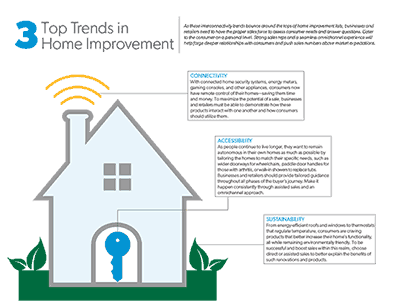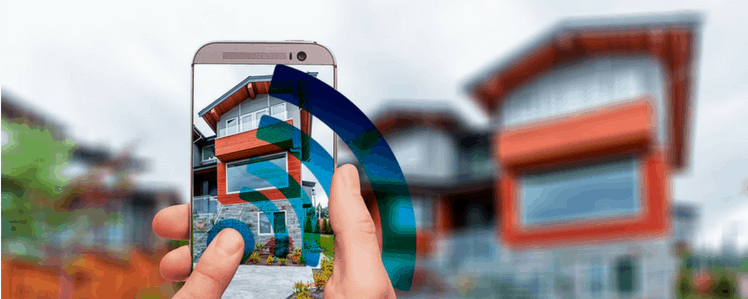Conducted earlier this year, a LightStream Home Improvement survey found that 45% of people plan to spend $5,000 or more on projects, while “big spenders” will shoot for $35,000 or more. With such stats, it’s not surprising that businesses and retailers are preparing for consumers who are itching to renovate and who are research-savvy across multiple channels. The consumer spending market has been on the rise since 2012 and is expected to have continued growth throughout 2018. This is good news for the home improvement industry, as retailers look to drive new and repeat customers.
So, what trends can we expect this year? How do we define them? And more importantly, how can these insights help professionals both market to and communicate with consumers more effectively?
Connectivity
The connected home tops many trends lists for 2018 but is most prominent in the home improvement vertical. With connected home security systems, energy meters, gaming consoles, and other appliances, consumers now have remote control of their homes—saving them time and money. Issues arise when consumers lack a comprehensive understanding of how these devices work together to create one harmonious system. To maximize the potential of a sale, businesses and retailers must be able to demonstrate how these products interact with one another and how consumers should utilize them, especially since “3 in 10 internet users now own at least one connected home device,” Sensi Comfort reports. Moreover, an omnichannel approach will work best, because you can meet the consumer wherever they are in the buying journey and be better prepared to address their concerns.
Accessibility
 Older consumers are staying put—not wanting to move into a nursing home or an assisted living space. As people continue to live longer, they want to remain autonomous in their own homes as much as possible. The solution? Tailor the homes to match their specific needs, such as wider doorways for wheelchairs, paddle door handles for those with arthritis, or walk-in showers to replace tubs. Renovations to maximize space and optimize function will continue to grow throughout 2018, thus calling for businesses and retailers to provide tailored guidance throughout all phases of the buyer’s journey. Make it happen consistently through assisted sales and an omnichannel approach.
Older consumers are staying put—not wanting to move into a nursing home or an assisted living space. As people continue to live longer, they want to remain autonomous in their own homes as much as possible. The solution? Tailor the homes to match their specific needs, such as wider doorways for wheelchairs, paddle door handles for those with arthritis, or walk-in showers to replace tubs. Renovations to maximize space and optimize function will continue to grow throughout 2018, thus calling for businesses and retailers to provide tailored guidance throughout all phases of the buyer’s journey. Make it happen consistently through assisted sales and an omnichannel approach.
Sustainability
With “Go Green!” campaigns continuing to infiltrate emails and the hearts and values of consumers, it’s no surprise that sustainability renovations also top many home improvement lists. When consumers can afford to alter or add smart home products, they are choosing options that align with sustainability. From energy-efficient roofs and windows to thermostats that regulate temperature, consumers are craving products that better increase their home’s functionality, all while remaining environmentally friendly. New tracking devices can gauge electricity usage and provide consumers with real-time feedback on how well their home is performing in terms of energy. In addition to valuing sustainability, cost plays hugely into purchasing decisions—with some renovations costing upwards of $6,000. To be successful and boost sales within the sustainability realm, choose direct or assisted sales to better explain the benefits of such renovations and products.
As these interconnectivity trends bounce around the tops of home improvement lists this year, businesses and retailers need to have the proper sales force to assess consumer needs and answer questions. Cater to the consumer on a personal level. Strong sales reps and a seamless omnichannel experience will help forge deeper relationships with consumers and push sales numbers above market expectations.
It’s more important than ever to help people in the exact moment they are making these expensive decisions. Connect with MarketSource and uncover how utilizing direct and assisted sales teams and mastering the omnichannel approach will increase sales and deliver an exceptional customer experience.

